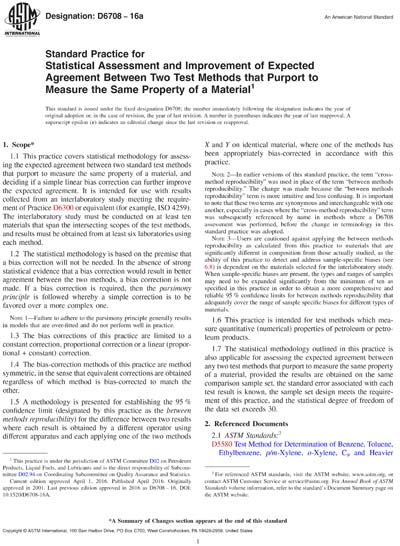Historical
ASTM D6708-16a
Standard Practice for Statistical Assessment and Improvement of Expected Agreement Between Two Test Methods that Purport to Measure the Same Property of a Material
1.1 This practice covers statistical methodology for assessing the expected agreement between two standard test methods that purport to measure the same property of a material, and deciding if a simple linear bias correction can further improve the expected agreement. It is intended for use with results collected from an interlaboratory study meeting the requirement of Practice D6300 or equivalent (for example, ISO 4259). The interlaboratory study must be conducted on at least ten materials that span the intersecting scopes of the test methods, and results must be obtained from at least six laboratories using each method.
1.2 The statistical methodology is based on the premise that a bias correction will not be needed. In the absence of strong statistical evidence that a bias correction would result in better agreement between the two methods, a bias correction is not made. If a bias correction is required, then the parsimony principle is followed whereby a simple correction is to be favored over a more complex one.
1.3 The bias corrections of this practice are limited to a constant correction, proportional correction or a linear (proportional + constant) correction.
1.4 The bias-correction methods of this practice are method symmetric, in the sense that equivalent corrections are obtained regardless of which method is bias-corrected to match the other.
1.5 A methodology is presented for establishing the 95 % confidence limit (designated by this practice as the between methods reproducibility) for the difference between two results where each result is obtained by a different operator using different apparatus and each applying one of the two methods X and Y on identical material, where one of the methods has been appropriately bias-corrected in accordance with this practice.
1.6 This practice is intended for test methods which measure quantitative (numerical) properties of petroleum or petroleum products.
1.7 The statistical methodology outlined in this practice is also applicable for assessing the expected agreement between any two test methods that purport to measure the same property of a material, provided the results are obtained on the same comparison sample set, the standard error associated with each test result is known, the sample set design meets the requirement of this practice, and the statistical degree of freedom of the data set exceeds 30.
Content Provider
ASTM International [astm]






